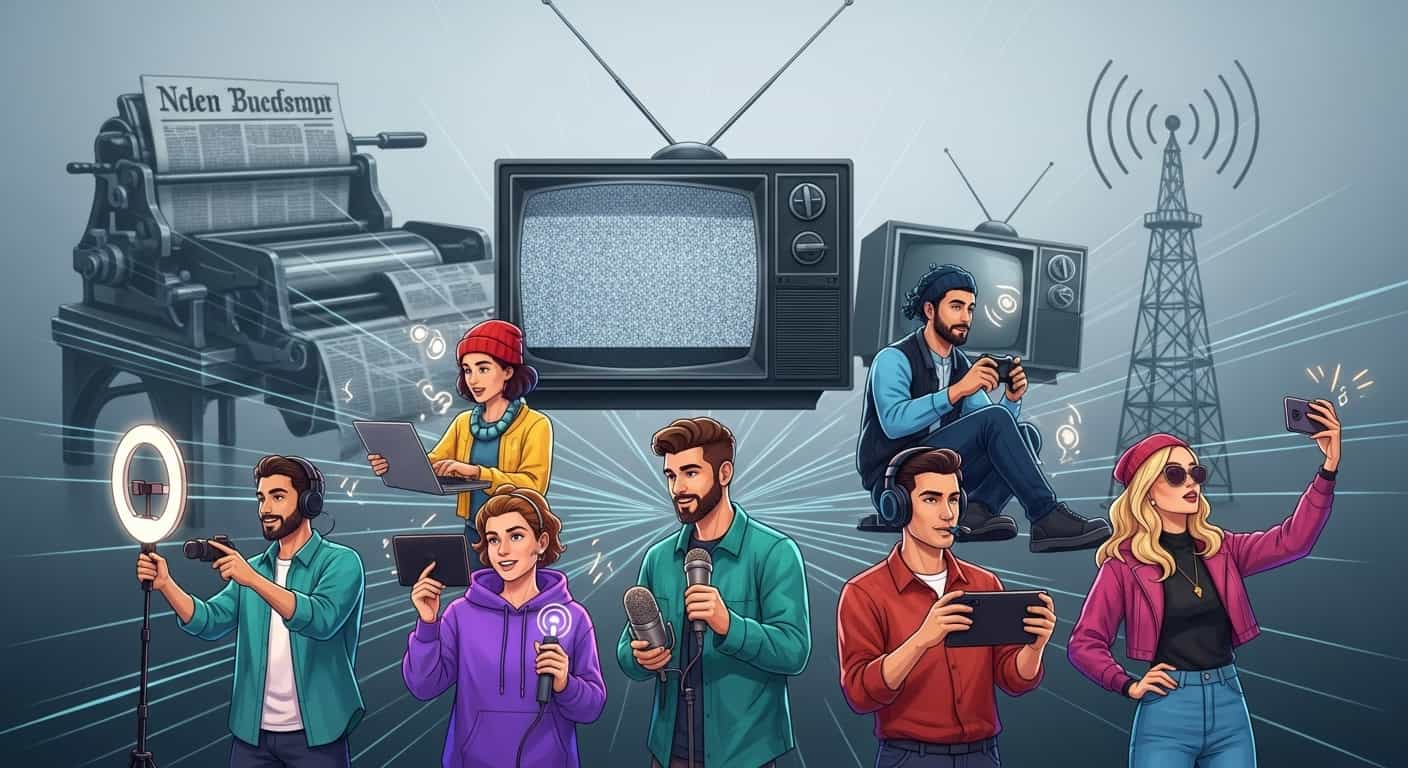The media landscape has transformed dramatically over the past decade. Social media platforms have given rise to a new breed of content creators who command massive audiences and shape public opinion. This shift raises a critical question: Are Influencers Replacing Traditional Journalists in Media Consumption?
The Changing Face of Media Consumption
Traditional media outlets once held an unshakeable grip on how people consumed news and information. Newspapers, television networks, and radio stations served as the primary gatekeepers of public discourse. However, the digital revolution has fundamentally altered this dynamic.
Today’s audiences increasingly turn to social media personalities for news, opinions, and analysis. These influencers often present information in more accessible, engaging formats that resonate with younger demographics who find traditional media outdated or disconnected from their experiences.
Understanding the Influencer Media Model
Content Creation and Distribution
Influencers operate on entirely different principles than traditional journalists. While journalists typically work within established editorial frameworks, influencers enjoy greater creative freedom and direct audience relationships.
Key differences include:
- Direct audience engagement through comments and messages
- Real-time content creation and publication
- Personal branding integrated with informational content
- Algorithm-driven distribution rather than editorial curation
Audience Relationship Dynamics
The relationship between influencers and their audiences differs significantly from traditional media relationships. Followers often feel a personal connection to influencers, viewing them as trusted friends rather than distant authority figures.
The Appeal of Influencer-Generated Content
Authenticity and Relatability
Many consumers find influencer content more authentic than traditional media. Influencers share personal experiences, speak in conversational tones, and present information in formats that feel natural and unfiltered.
This perceived authenticity creates stronger emotional connections between content creators and their audiences. People often trust recommendations and information from influencers they follow more than they trust traditional news sources.
Accessibility and Format Innovation
Influencers excel at making complex information accessible through:
- Visual storytelling with infographics and videos
- Simplified explanations of complicated topics
- Interactive content that encourages participation
- Multi-platform distribution reaching audiences where they spend time
| Traditional Media Format | Influencer Innovation |
| Written articles | Video explanations |
| TV segments | Live streaming |
| Print interviews | Story highlights |
| Editorial columns | Personal vlogs |
Traditional Journalism’s Unique Value Proposition
Professional Standards and Ethics
Traditional journalists operate under established ethical codes and professional standards that influencers may not follow. These include:
- Fact-checking procedures and verification processes
- Editorial oversight and accountability measures
- Source protection and confidentiality protocols
- Objectivity standards and bias management
Investigative Capabilities
Professional journalists possess resources and training that most influencers lack:
- Investigative research skills and methodologies
- Legal protection for source confidentiality
- Institutional support for complex, long-term projects
- Professional networks for information gathering
Platforms like www influencersgonewild co uk and www whatabigailsays co uk often highlight the importance of understanding these distinctions when evaluating the credibility of different information sources.
The Credibility Question
Information Verification Challenges
Are Influencers Replacing Traditional Journalists in Media Consumption? One major concern is the varying levels of information verification among influencers. While traditional media has established fact-checking processes, influencer content may lack rigorous verification.
Bias and Commercial Interests
Influencers face different incentive structures than traditional journalists:
- Sponsored content requirements may influence coverage
- Personal brand protection can limit controversial topics
- Algorithm optimization may prioritize engagement over accuracy
- Commercial partnerships can create conflicts of interest
Hybrid Models and Collaboration
Journalist-Influencers
Many traditional journalists have embraced social media platforms, becoming influencers in their own right. This hybrid approach combines professional training with digital engagement strategies.
Benefits include:
- Professional credibility with social media reach
- Direct audience relationships without institutional barriers
- Diverse revenue streams beyond traditional employment
- Creative freedom within professional standards
Media Organizations Adapting
Traditional media companies increasingly collaborate with influencers or adopt influencer-style content strategies:
- Social media presence expansion
- Video-first content strategies
- Personality-driven programming
- Interactive engagement with audiences
Demographic Divides in Media Consumption
Generational Preferences
Different age groups consume media differently:
Younger Demographics (18-34):
- Prefer visual content formats
- Trust peer recommendations over institutional sources
- Consume news through social media feeds
- Value accessibility over comprehensive coverage
Older Demographics (35+):
- Rely on traditional news sources
- Value institutional credibility
- Prefer in-depth analysis over quick updates
- Trust professional journalism standards
Platform-Specific Behaviors
Media consumption varies significantly across platforms:
- Instagram: Visual news and lifestyle content
- Twitter/X: Real-time updates and commentary
- TikTok: Bite-sized educational content
- YouTube: Long-form analysis and explanations
The Economics of Modern Media
Revenue Model Disruption
Traditional media faces significant economic challenges:
- Declining circulation and viewership
- Advertising revenue migration to digital platforms
- Subscription fatigue among consumers
- Competition from free influencer content
Influencers, meanwhile, benefit from:
- Direct monetization through sponsorships
- Multiple revenue streams (merchandise, courses, etc.)
- Lower overhead costs
- Flexible business models
Investment and Resource Allocation
The economics favor influencer content creation in many ways:
- Lower production costs for video content
- Faster content turnaround times
- Direct audience measurement and feedback
- Agile response to trending topics
Quality vs. Quantity Considerations
Content Volume and Frequency
Influencers typically produce content at much higher frequencies than traditional media outlets. While this keeps audiences engaged, it raises questions about content quality and depth.
Depth of Analysis
Traditional journalism often provides more comprehensive analysis:
- Historical context and background information
- Multiple source verification and corroboration
- Complex investigation and research
- Long-term follow-up on developing stories
The Future of Media Consumption
Complementary Rather Than Replacement
Rather than complete replacement, the evidence suggests a more nuanced relationship between influencers and traditional journalists. Different content serves different purposes:
Influencers Excel At:
- Breaking news and real-time updates
- Personal perspective and opinion content
- Educational content in accessible formats
- Community building around shared interests
Traditional Journalists Excel At:
- Investigative reporting and complex analysis
- Institutional accountability and watchdog functions
- Historical context and comprehensive coverage
- Ethical standards and professional verification
Integration and Evolution
The most successful media strategies increasingly integrate both approaches:
- Traditional outlets adopting influencer techniques
- Influencers incorporating journalistic standards
- Collaborative projects combining both strengths
- Audience education about source evaluation
Challenges and Concerns
Information Quality Control
The democratization of media creation presents challenges:
- Misinformation spread through influential platforms
- Lack of editorial oversight and fact-checking
- Echo chamber effects and confirmation bias
- Difficulty distinguishing credible from unreliable sources
Professional Development
As the media landscape evolves, both traditional journalists and influencers must adapt:
- Skill development in digital platforms and engagement
- Understanding of new media economics
- Ethical training for influencer responsibilities
- Technical expertise in content creation tools
Conclusion
Are Influencers Replacing Traditional Journalists in Media Consumption? The answer isn’t a simple yes or no. Instead, we’re witnessing a fundamental transformation in how people access, process, and engage with information.
Influencers have certainly disrupted traditional media consumption patterns, particularly among younger demographics. Their ability to create authentic, accessible content that builds genuine audience relationships represents a significant shift in media dynamics.
However, traditional journalism continues to provide unique value through professional standards, investigative capabilities, and institutional accountability that influencers typically cannot match.
The future likely belongs to those who can successfully integrate the best aspects of both approaches: the engagement and accessibility of influencer content with the credibility and depth of professional journalism. Media consumers benefit most when they can access diverse sources and develop critical thinking skills to evaluate information quality regardless of its source.
Understanding this evolving landscape helps both content creators and consumers navigate the complex modern media environment more effectively. Success comes not from choosing one approach over another, but from recognizing the strengths and limitations of each and using them strategically to stay informed in an increasingly complex world.


